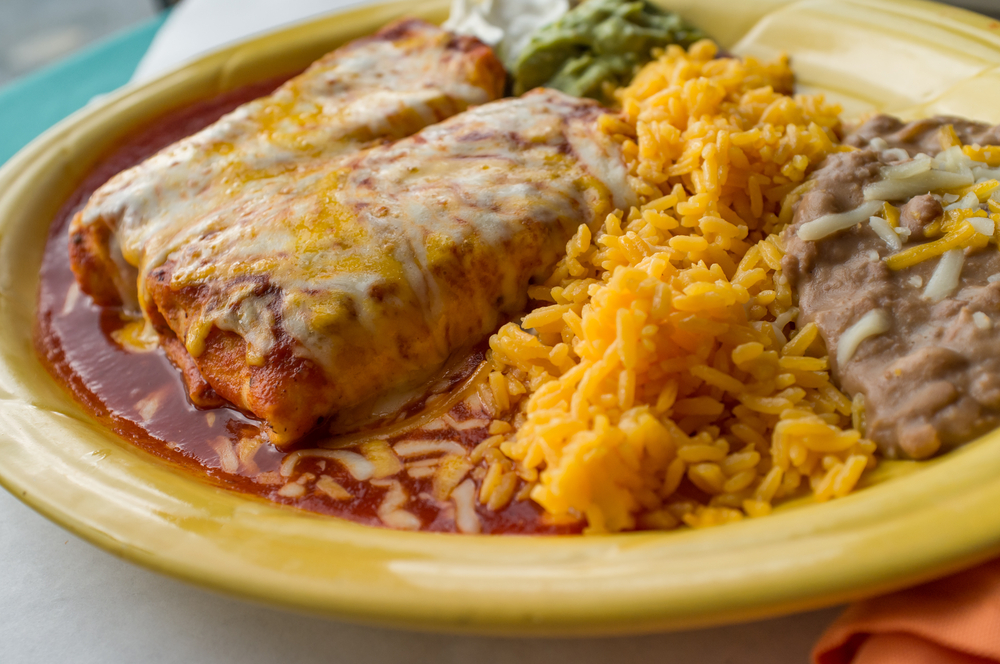
Editor’s note: The author and I grew up in the same region of the country, going to the same sorts of restaurants. Bear with me if I cut in to add my two cents from time to time.
Over the last few years, region specific Mexican cuisines have started taking a strong hold on American food culture. You can find Baja taco trucks specializing in Baja norte or Baja sud cuisine; authentic gordita poblanos are slung from behind craft tequila bars in hipster neighborhoods; and people have developed serious opinions about al pastor vs. carnitas.
There was a time not so long ago that going out for “Mexican” in the United States meant hitting a hole-in-the-wall joint downtown, or a restaurant in the middle of a strip mall. There you’d find a pan-Mexican menu of beans, tacos, enchiladas, nachos, burritos, chimichangas, dirty rice, sour cream, American cheese, sweet margaritas, and endless baskets of warm tortilla chips.
Those restaurants feel dated now and have taken a lot of slack with the introduction of “real” Mexican food into the modern consciousness. ‘Tex Mex’ — as it’s often called — is left out of the conversation about good Mexican food in 2017.
But isn’t there room for both? I’m not going to argue that my nostalgia for the Mexican joints of my youth means you owe them your business. If people aren’t going, they aren’t going. This is about the idea that maybe we don’t need to swing the pendulum so far all the time. Maybe there’s still a time and a place for shredded beef tacos with refried beans on the side.
https://www.instagram.com/p/5gFKxTLBgG/
A while back, I bonded with our fearless editor, Steve Bramucci, over our shared love of the Mexican joints our parents took us to as kids. It’s hard to beat the excitement of walking in the door of one of those “cantinas” to see baskets of warm chips being rushed to each table. We spoke about the flour tortillas kept in heavy plastic warming dishes, the pinnacle of fine dining. After a few minutes of reminiscing about combo platters of enchiladas and soft and crunchy tacos slathered in sour cream and red sauce, we decided we to trace this food back.
It turns out, none of it is particularly inauthentic… just more generic. Steve and my home states of Oregon and Washington make up two of the five states with the most agricultural workers. Many of these workers are Mexican and naturally restaurants sprung up to satisfy their food tastes. But as Mexican food became integral to American restaurant landscape, the hole in the wall Mexican places that Steve and I grew up going to had to please both real Mexicans migrants and interlopers — it was a tough gig and required plenty of recognizable dishes on the menu.
[Most of which were made with flour tortillas, even when corn was the traditional choice. — ed]
Question answered. But since Steve and I are both in the food world, we carried on lamenting at the decline of the classic Pacific Northwest Mexican joint. What was wrong with it? In an era of rustic food, why had hearty dishes meant to satisfy famers fallen out of favor? Why were beans and rice coming as side orders being dismissed by Mexican food purists?
This dismissal is silly of course. Not because of nostalgia, but because it’s kinda ridiculous to think that a plate of refried beans with a chimichanga, two tacos, and shitload of melted yellow cheese somehow isn’t Mexican.
[At the very least, it should deserve hipster cred for being “fusion.” — ed]
https://www.instagram.com/p/BPyRnFegnqv/
Is this Mexican food? Sure. The fare that pops up in even the smallest towns along the Pacific coast — commonly known as Tex-Mex — is just as Mexican as Oaxacan or Poblano or Baja cuisines. Tejanos in Texas — which was once Mexico and populated with Mexicans — had their own food styles that became popularized as Tex-Mex by 1875. That’s 15 years before pizza was “invented” in Naples by the way.
Moreover, Tex-Mex specifically referred to the Texas-Mexicans who sold tortillas with beans at train stations across the state. Over the years nachos were invented in the same area, new combinations, and Cali-Mex standards (burritos) were added to the menus. These classic foods were tweaked and reinvented to what we have today — which is also still evolving.
The restaurants Steve and I discovered a shared love for were served migrant Mexican populations as they moved around America, found homes, raised families, and became a vital part of this nation. It’s no exaggeration to say that this food is part of our cultural fabric.
Would any of us tell Mario Batali he’s not making Italian food because he cooks up a feast of spaghetti with meatballs (an American invention)? Of course not. It would be absurd. He’s an Italian migrant who is making an adaptation of Italian food that we all love. Yet, there’s always someone eager to tell the world of the pitfalls and failures of Tex-Mex. It’s a mindset that’s disrespectful to the generations of Mexicans who created an entire cuisine and served it across America.
[Also, “goodness” shouldn’t be argued with and beef chimichangas from a place called Mission Catina inevitably make for a deeply satisfying meal. –ed]
There’s a storied history of Mexican and Hispanic migrants in America adding to our culture in ways that help make America great. All those little hole-in-the-wall Mexican restaurants slinging variation of Tex-Mex are part of the American experience that celebrates our shared heritage. That’s something worthy of love, not snobbery. Besides, who can argue with a bottomless basket of warm tortilla chips and a little mortar bowl of salsa roja while waiting for combo platter #5 and a second margarita?
https://www.instagram.com/p/BMAVwAphZvs/
https://www.instagram.com/p/BS2Sp7fgxET/
https://www.instagram.com/p/8MAWjConn0/
https://www.instagram.com/p/BHymNuFjuwU/






